Ethical Issues and Principles in Healthcare: Case Study Analysis
VerifiedAdded on 2020/04/29
|12
|2928
|117
Essay
AI Summary
This essay provides a comprehensive analysis of ethical issues and principles within the healthcare domain, focusing on a case study involving a physiotherapist, a patient, and a surgeon. The essay delves into the application of deontological and utilitarian ethical frameworks to the scenarios presented, highlighting the conflicts that arise and the considerations necessary for ethical decision-making. It examines the importance of professional codes of conduct, particularly the Australian Physiotherapy Association (APA) guidelines, and their implications in practice. The essay also explores the significance of human rights in healthcare, emphasizing the right to the highest attainable standard of health and the quality of care. Furthermore, it discusses key ethical principles such as non-maleficence, beneficence, and autonomy, and their relevance in clinical settings. The essay concludes with proposals for professional practice, emphasizing the need for healthcare professionals to balance ethical approaches, adhere to professional codes, and understand ethical principles to provide competent and ethical patient care.
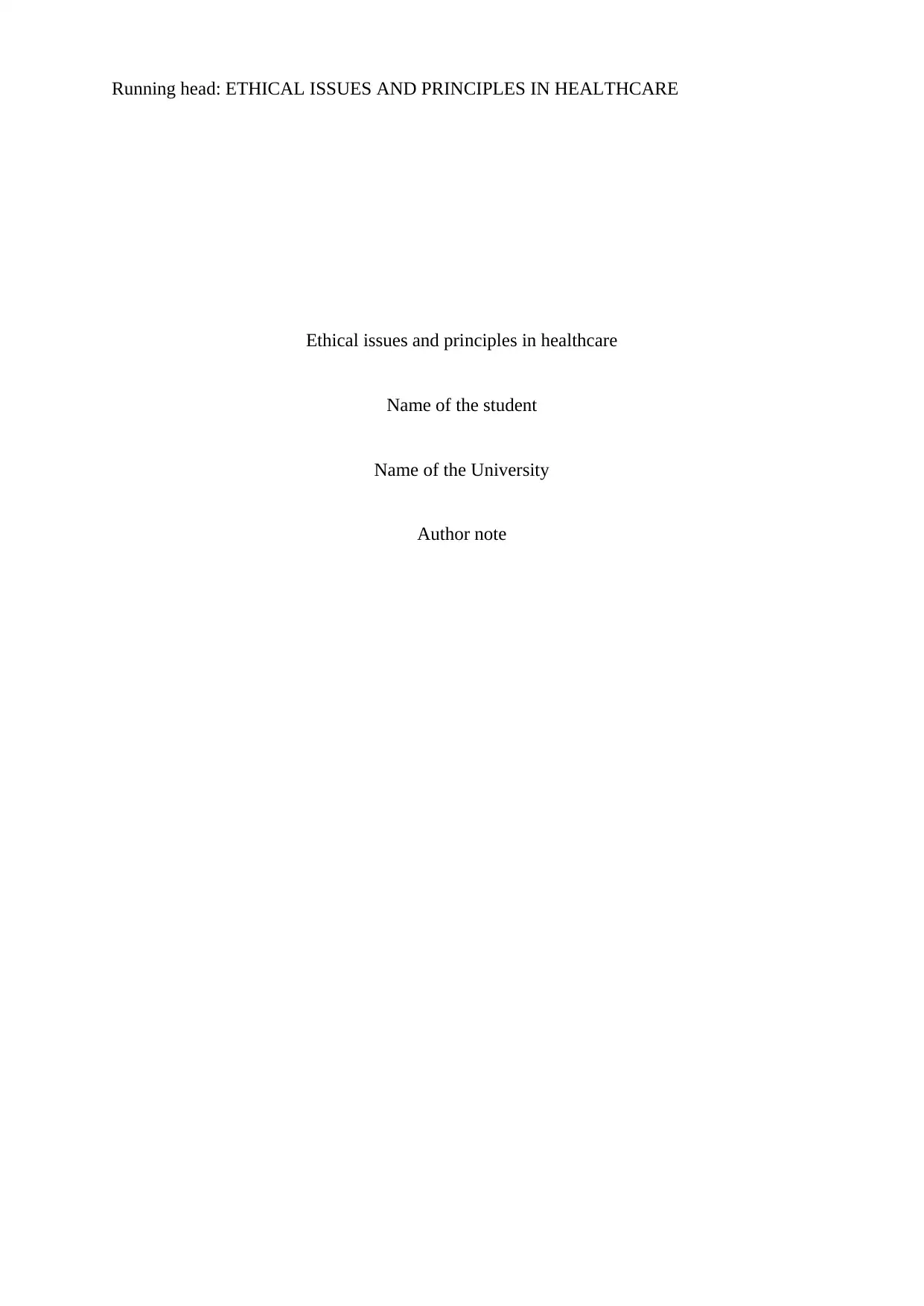
Running head: ETHICAL ISSUES AND PRINCIPLES IN HEALTHCARE
Ethical issues and principles in healthcare
Name of the student
Name of the University
Author note
Ethical issues and principles in healthcare
Name of the student
Name of the University
Author note
Paraphrase This Document
Need a fresh take? Get an instant paraphrase of this document with our AI Paraphraser
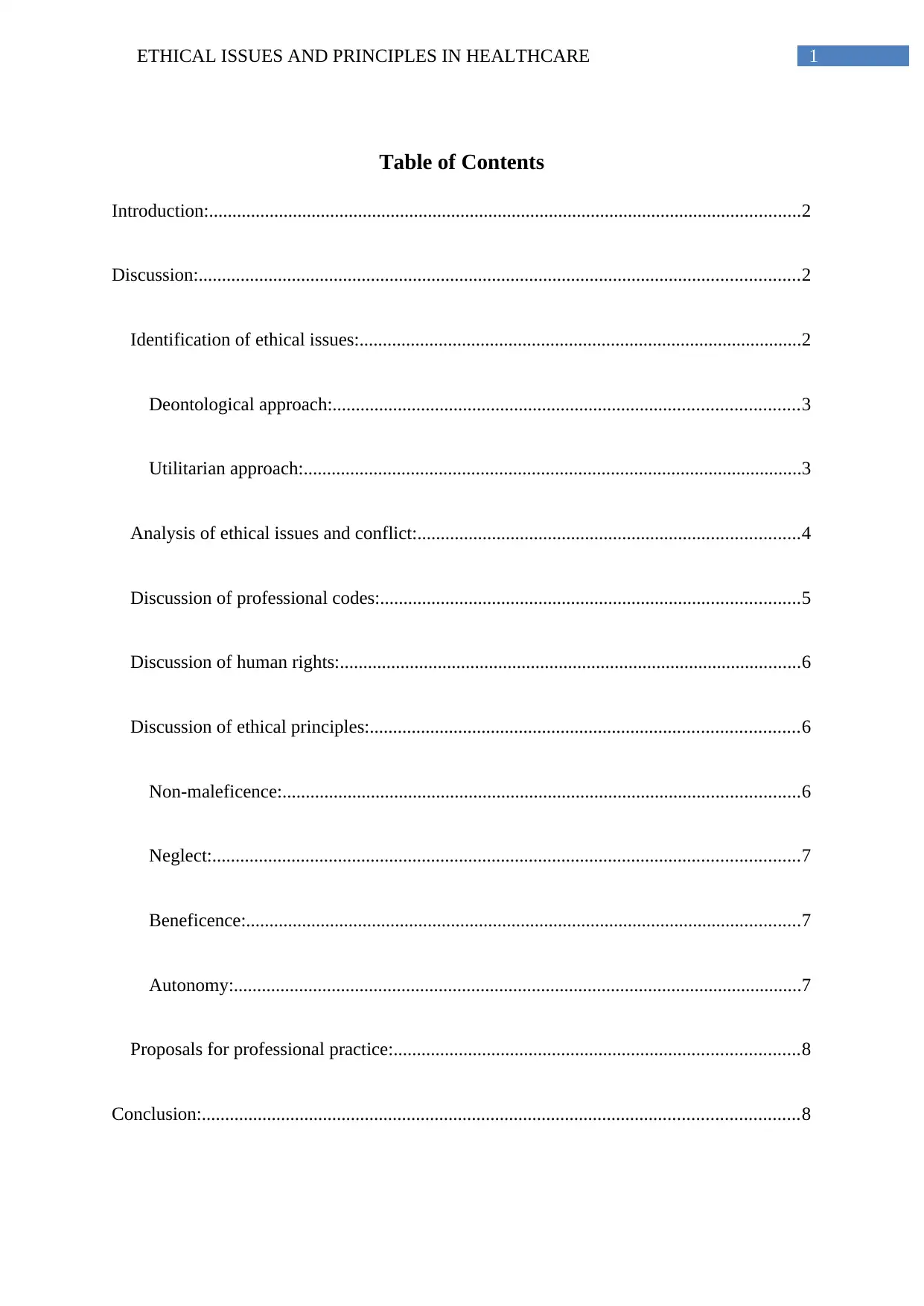
1ETHICAL ISSUES AND PRINCIPLES IN HEALTHCARE
Table of Contents
Introduction:...............................................................................................................................2
Discussion:.................................................................................................................................2
Identification of ethical issues:...............................................................................................2
Deontological approach:....................................................................................................3
Utilitarian approach:...........................................................................................................3
Analysis of ethical issues and conflict:..................................................................................4
Discussion of professional codes:..........................................................................................5
Discussion of human rights:...................................................................................................6
Discussion of ethical principles:............................................................................................6
Non-maleficence:...............................................................................................................6
Neglect:..............................................................................................................................7
Beneficence:.......................................................................................................................7
Autonomy:..........................................................................................................................7
Proposals for professional practice:.......................................................................................8
Conclusion:................................................................................................................................8
Table of Contents
Introduction:...............................................................................................................................2
Discussion:.................................................................................................................................2
Identification of ethical issues:...............................................................................................2
Deontological approach:....................................................................................................3
Utilitarian approach:...........................................................................................................3
Analysis of ethical issues and conflict:..................................................................................4
Discussion of professional codes:..........................................................................................5
Discussion of human rights:...................................................................................................6
Discussion of ethical principles:............................................................................................6
Non-maleficence:...............................................................................................................6
Neglect:..............................................................................................................................7
Beneficence:.......................................................................................................................7
Autonomy:..........................................................................................................................7
Proposals for professional practice:.......................................................................................8
Conclusion:................................................................................................................................8
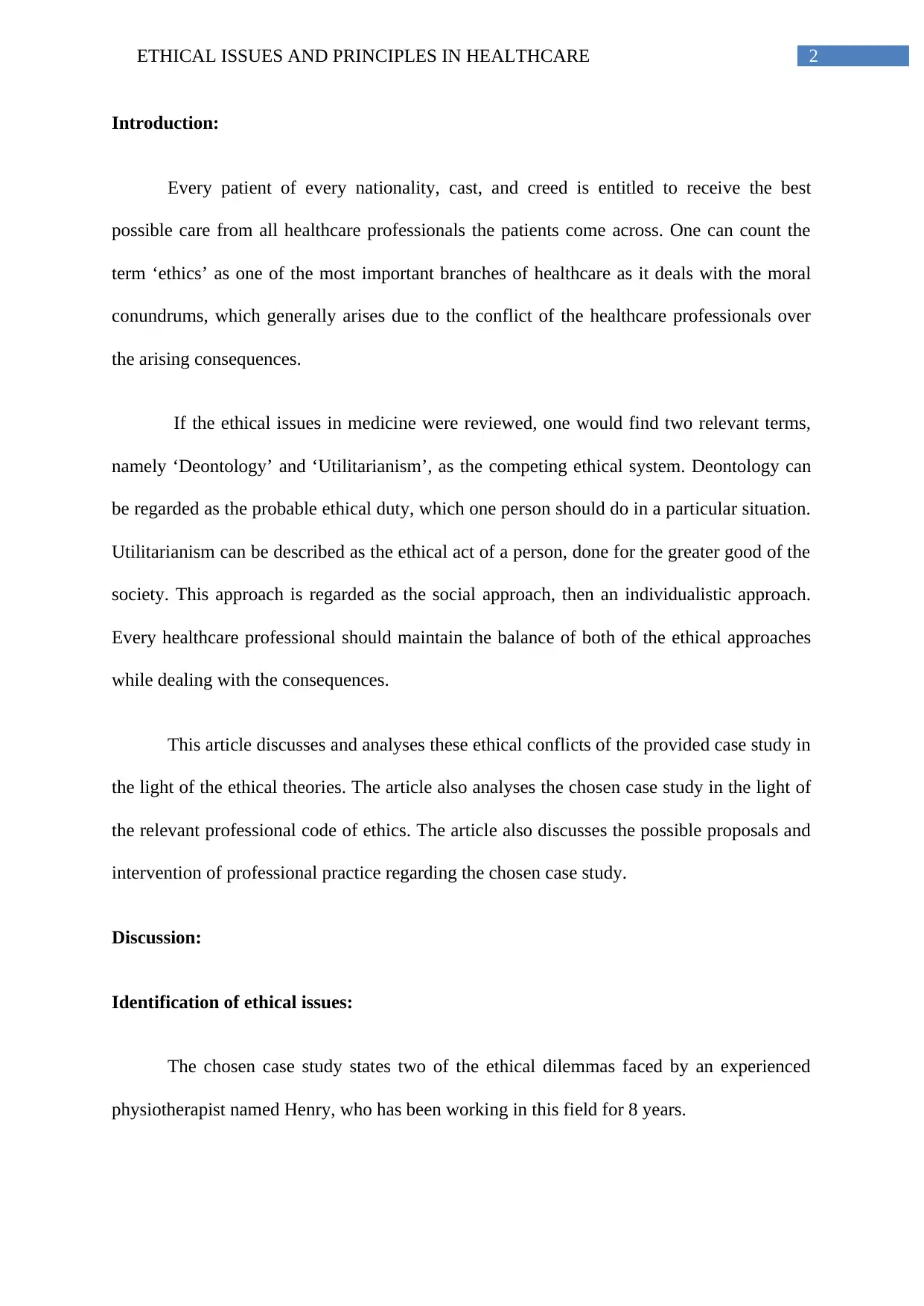
2ETHICAL ISSUES AND PRINCIPLES IN HEALTHCARE
Introduction:
Every patient of every nationality, cast, and creed is entitled to receive the best
possible care from all healthcare professionals the patients come across. One can count the
term ‘ethics’ as one of the most important branches of healthcare as it deals with the moral
conundrums, which generally arises due to the conflict of the healthcare professionals over
the arising consequences.
If the ethical issues in medicine were reviewed, one would find two relevant terms,
namely ‘Deontology’ and ‘Utilitarianism’, as the competing ethical system. Deontology can
be regarded as the probable ethical duty, which one person should do in a particular situation.
Utilitarianism can be described as the ethical act of a person, done for the greater good of the
society. This approach is regarded as the social approach, then an individualistic approach.
Every healthcare professional should maintain the balance of both of the ethical approaches
while dealing with the consequences.
This article discusses and analyses these ethical conflicts of the provided case study in
the light of the ethical theories. The article also analyses the chosen case study in the light of
the relevant professional code of ethics. The article also discusses the possible proposals and
intervention of professional practice regarding the chosen case study.
Discussion:
Identification of ethical issues:
The chosen case study states two of the ethical dilemmas faced by an experienced
physiotherapist named Henry, who has been working in this field for 8 years.
Introduction:
Every patient of every nationality, cast, and creed is entitled to receive the best
possible care from all healthcare professionals the patients come across. One can count the
term ‘ethics’ as one of the most important branches of healthcare as it deals with the moral
conundrums, which generally arises due to the conflict of the healthcare professionals over
the arising consequences.
If the ethical issues in medicine were reviewed, one would find two relevant terms,
namely ‘Deontology’ and ‘Utilitarianism’, as the competing ethical system. Deontology can
be regarded as the probable ethical duty, which one person should do in a particular situation.
Utilitarianism can be described as the ethical act of a person, done for the greater good of the
society. This approach is regarded as the social approach, then an individualistic approach.
Every healthcare professional should maintain the balance of both of the ethical approaches
while dealing with the consequences.
This article discusses and analyses these ethical conflicts of the provided case study in
the light of the ethical theories. The article also analyses the chosen case study in the light of
the relevant professional code of ethics. The article also discusses the possible proposals and
intervention of professional practice regarding the chosen case study.
Discussion:
Identification of ethical issues:
The chosen case study states two of the ethical dilemmas faced by an experienced
physiotherapist named Henry, who has been working in this field for 8 years.
⊘ This is a preview!⊘
Do you want full access?
Subscribe today to unlock all pages.

Trusted by 1+ million students worldwide
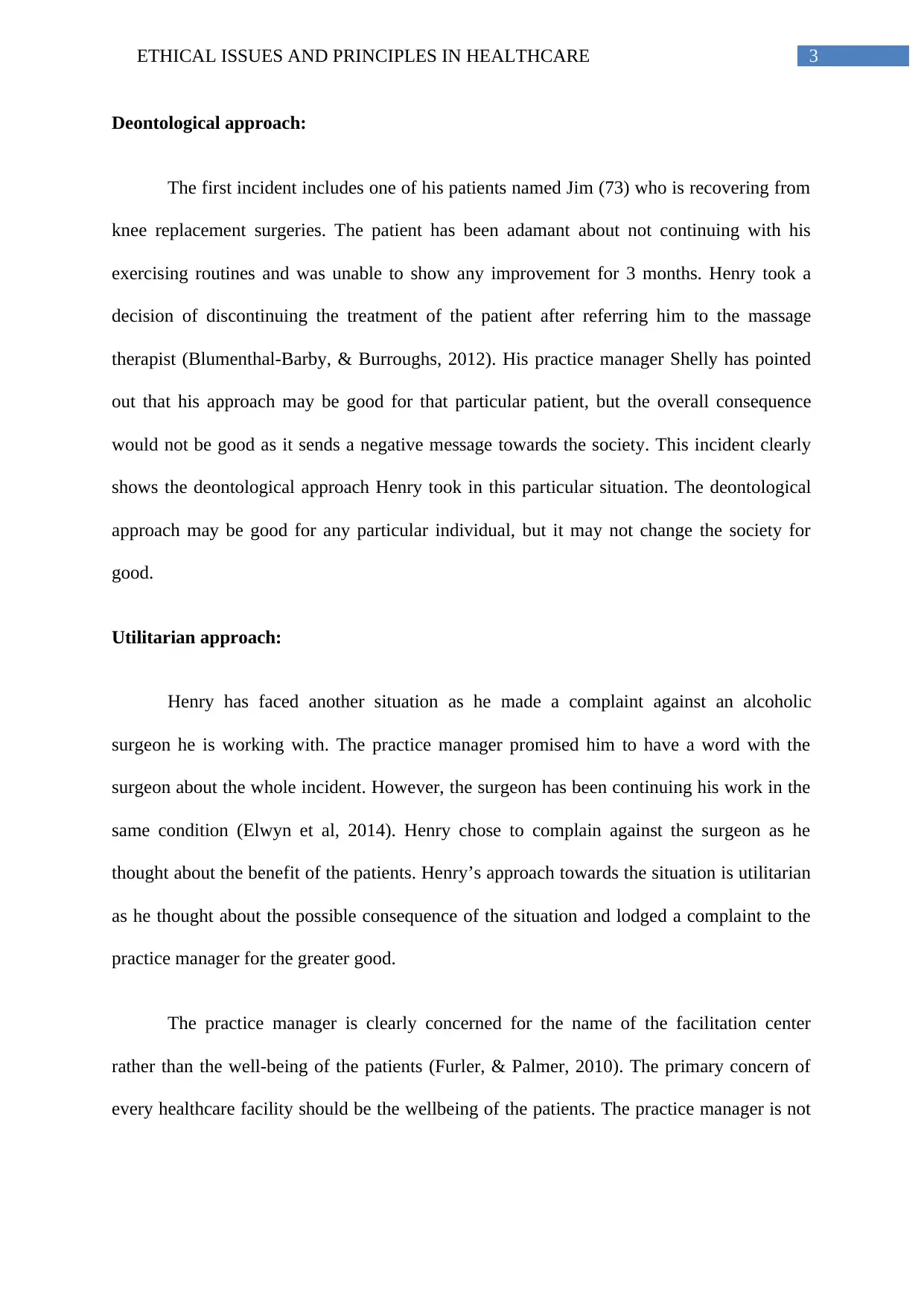
3ETHICAL ISSUES AND PRINCIPLES IN HEALTHCARE
Deontological approach:
The first incident includes one of his patients named Jim (73) who is recovering from
knee replacement surgeries. The patient has been adamant about not continuing with his
exercising routines and was unable to show any improvement for 3 months. Henry took a
decision of discontinuing the treatment of the patient after referring him to the massage
therapist (Blumenthal-Barby, & Burroughs, 2012). His practice manager Shelly has pointed
out that his approach may be good for that particular patient, but the overall consequence
would not be good as it sends a negative message towards the society. This incident clearly
shows the deontological approach Henry took in this particular situation. The deontological
approach may be good for any particular individual, but it may not change the society for
good.
Utilitarian approach:
Henry has faced another situation as he made a complaint against an alcoholic
surgeon he is working with. The practice manager promised him to have a word with the
surgeon about the whole incident. However, the surgeon has been continuing his work in the
same condition (Elwyn et al, 2014). Henry chose to complain against the surgeon as he
thought about the benefit of the patients. Henry’s approach towards the situation is utilitarian
as he thought about the possible consequence of the situation and lodged a complaint to the
practice manager for the greater good.
The practice manager is clearly concerned for the name of the facilitation center
rather than the well-being of the patients (Furler, & Palmer, 2010). The primary concern of
every healthcare facility should be the wellbeing of the patients. The practice manager is not
Deontological approach:
The first incident includes one of his patients named Jim (73) who is recovering from
knee replacement surgeries. The patient has been adamant about not continuing with his
exercising routines and was unable to show any improvement for 3 months. Henry took a
decision of discontinuing the treatment of the patient after referring him to the massage
therapist (Blumenthal-Barby, & Burroughs, 2012). His practice manager Shelly has pointed
out that his approach may be good for that particular patient, but the overall consequence
would not be good as it sends a negative message towards the society. This incident clearly
shows the deontological approach Henry took in this particular situation. The deontological
approach may be good for any particular individual, but it may not change the society for
good.
Utilitarian approach:
Henry has faced another situation as he made a complaint against an alcoholic
surgeon he is working with. The practice manager promised him to have a word with the
surgeon about the whole incident. However, the surgeon has been continuing his work in the
same condition (Elwyn et al, 2014). Henry chose to complain against the surgeon as he
thought about the benefit of the patients. Henry’s approach towards the situation is utilitarian
as he thought about the possible consequence of the situation and lodged a complaint to the
practice manager for the greater good.
The practice manager is clearly concerned for the name of the facilitation center
rather than the well-being of the patients (Furler, & Palmer, 2010). The primary concern of
every healthcare facility should be the wellbeing of the patients. The practice manager is not
Paraphrase This Document
Need a fresh take? Get an instant paraphrase of this document with our AI Paraphraser
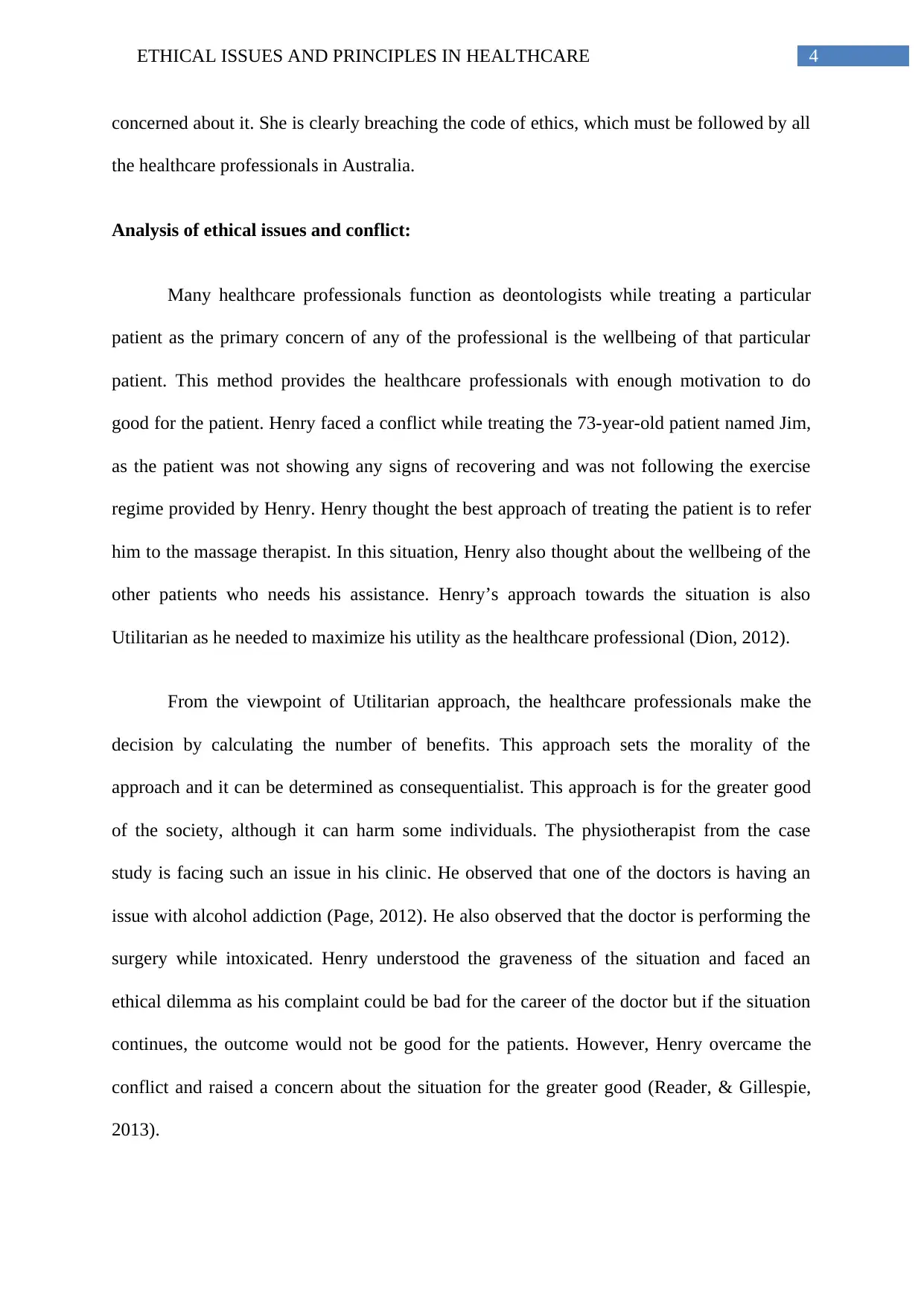
4ETHICAL ISSUES AND PRINCIPLES IN HEALTHCARE
concerned about it. She is clearly breaching the code of ethics, which must be followed by all
the healthcare professionals in Australia.
Analysis of ethical issues and conflict:
Many healthcare professionals function as deontologists while treating a particular
patient as the primary concern of any of the professional is the wellbeing of that particular
patient. This method provides the healthcare professionals with enough motivation to do
good for the patient. Henry faced a conflict while treating the 73-year-old patient named Jim,
as the patient was not showing any signs of recovering and was not following the exercise
regime provided by Henry. Henry thought the best approach of treating the patient is to refer
him to the massage therapist. In this situation, Henry also thought about the wellbeing of the
other patients who needs his assistance. Henry’s approach towards the situation is also
Utilitarian as he needed to maximize his utility as the healthcare professional (Dion, 2012).
From the viewpoint of Utilitarian approach, the healthcare professionals make the
decision by calculating the number of benefits. This approach sets the morality of the
approach and it can be determined as consequentialist. This approach is for the greater good
of the society, although it can harm some individuals. The physiotherapist from the case
study is facing such an issue in his clinic. He observed that one of the doctors is having an
issue with alcohol addiction (Page, 2012). He also observed that the doctor is performing the
surgery while intoxicated. Henry understood the graveness of the situation and faced an
ethical dilemma as his complaint could be bad for the career of the doctor but if the situation
continues, the outcome would not be good for the patients. However, Henry overcame the
conflict and raised a concern about the situation for the greater good (Reader, & Gillespie,
2013).
concerned about it. She is clearly breaching the code of ethics, which must be followed by all
the healthcare professionals in Australia.
Analysis of ethical issues and conflict:
Many healthcare professionals function as deontologists while treating a particular
patient as the primary concern of any of the professional is the wellbeing of that particular
patient. This method provides the healthcare professionals with enough motivation to do
good for the patient. Henry faced a conflict while treating the 73-year-old patient named Jim,
as the patient was not showing any signs of recovering and was not following the exercise
regime provided by Henry. Henry thought the best approach of treating the patient is to refer
him to the massage therapist. In this situation, Henry also thought about the wellbeing of the
other patients who needs his assistance. Henry’s approach towards the situation is also
Utilitarian as he needed to maximize his utility as the healthcare professional (Dion, 2012).
From the viewpoint of Utilitarian approach, the healthcare professionals make the
decision by calculating the number of benefits. This approach sets the morality of the
approach and it can be determined as consequentialist. This approach is for the greater good
of the society, although it can harm some individuals. The physiotherapist from the case
study is facing such an issue in his clinic. He observed that one of the doctors is having an
issue with alcohol addiction (Page, 2012). He also observed that the doctor is performing the
surgery while intoxicated. Henry understood the graveness of the situation and faced an
ethical dilemma as his complaint could be bad for the career of the doctor but if the situation
continues, the outcome would not be good for the patients. However, Henry overcame the
conflict and raised a concern about the situation for the greater good (Reader, & Gillespie,
2013).
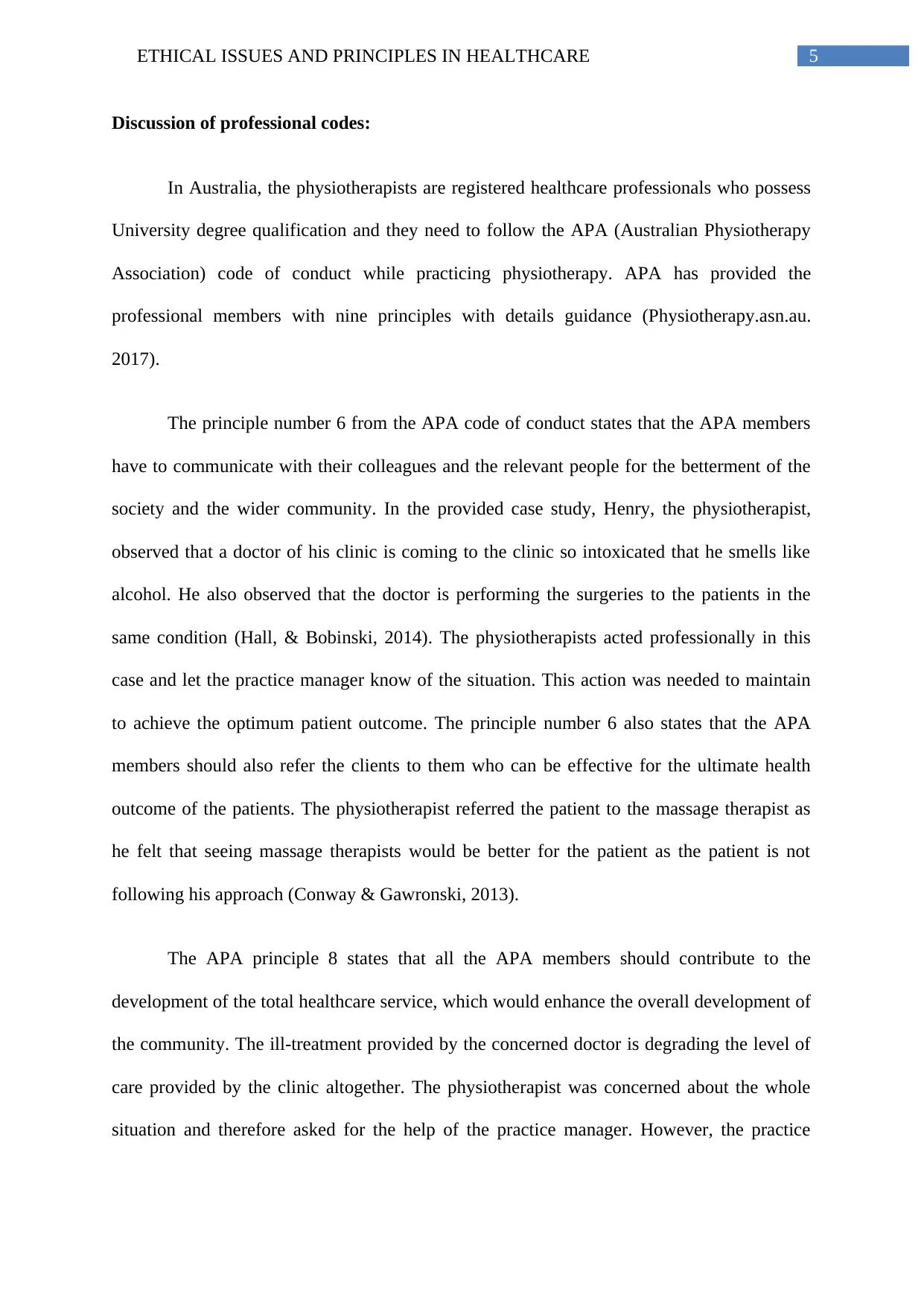
5ETHICAL ISSUES AND PRINCIPLES IN HEALTHCARE
Discussion of professional codes:
In Australia, the physiotherapists are registered healthcare professionals who possess
University degree qualification and they need to follow the APA (Australian Physiotherapy
Association) code of conduct while practicing physiotherapy. APA has provided the
professional members with nine principles with details guidance (Physiotherapy.asn.au.
2017).
The principle number 6 from the APA code of conduct states that the APA members
have to communicate with their colleagues and the relevant people for the betterment of the
society and the wider community. In the provided case study, Henry, the physiotherapist,
observed that a doctor of his clinic is coming to the clinic so intoxicated that he smells like
alcohol. He also observed that the doctor is performing the surgeries to the patients in the
same condition (Hall, & Bobinski, 2014). The physiotherapists acted professionally in this
case and let the practice manager know of the situation. This action was needed to maintain
to achieve the optimum patient outcome. The principle number 6 also states that the APA
members should also refer the clients to them who can be effective for the ultimate health
outcome of the patients. The physiotherapist referred the patient to the massage therapist as
he felt that seeing massage therapists would be better for the patient as the patient is not
following his approach (Conway & Gawronski, 2013).
The APA principle 8 states that all the APA members should contribute to the
development of the total healthcare service, which would enhance the overall development of
the community. The ill-treatment provided by the concerned doctor is degrading the level of
care provided by the clinic altogether. The physiotherapist was concerned about the whole
situation and therefore asked for the help of the practice manager. However, the practice
Discussion of professional codes:
In Australia, the physiotherapists are registered healthcare professionals who possess
University degree qualification and they need to follow the APA (Australian Physiotherapy
Association) code of conduct while practicing physiotherapy. APA has provided the
professional members with nine principles with details guidance (Physiotherapy.asn.au.
2017).
The principle number 6 from the APA code of conduct states that the APA members
have to communicate with their colleagues and the relevant people for the betterment of the
society and the wider community. In the provided case study, Henry, the physiotherapist,
observed that a doctor of his clinic is coming to the clinic so intoxicated that he smells like
alcohol. He also observed that the doctor is performing the surgeries to the patients in the
same condition (Hall, & Bobinski, 2014). The physiotherapists acted professionally in this
case and let the practice manager know of the situation. This action was needed to maintain
to achieve the optimum patient outcome. The principle number 6 also states that the APA
members should also refer the clients to them who can be effective for the ultimate health
outcome of the patients. The physiotherapist referred the patient to the massage therapist as
he felt that seeing massage therapists would be better for the patient as the patient is not
following his approach (Conway & Gawronski, 2013).
The APA principle 8 states that all the APA members should contribute to the
development of the total healthcare service, which would enhance the overall development of
the community. The ill-treatment provided by the concerned doctor is degrading the level of
care provided by the clinic altogether. The physiotherapist was concerned about the whole
situation and therefore asked for the help of the practice manager. However, the practice
⊘ This is a preview!⊘
Do you want full access?
Subscribe today to unlock all pages.

Trusted by 1+ million students worldwide
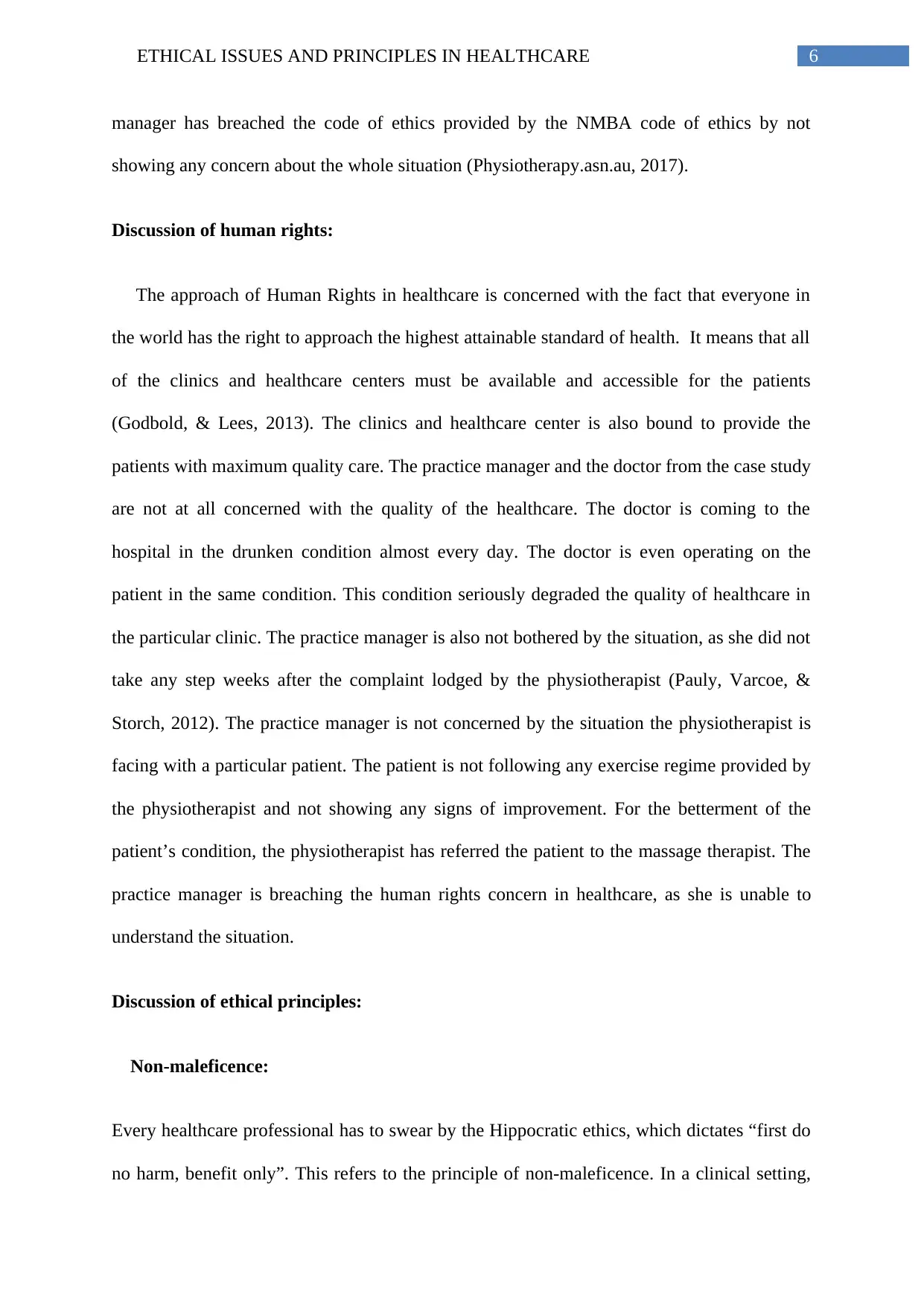
6ETHICAL ISSUES AND PRINCIPLES IN HEALTHCARE
manager has breached the code of ethics provided by the NMBA code of ethics by not
showing any concern about the whole situation (Physiotherapy.asn.au, 2017).
Discussion of human rights:
The approach of Human Rights in healthcare is concerned with the fact that everyone in
the world has the right to approach the highest attainable standard of health. It means that all
of the clinics and healthcare centers must be available and accessible for the patients
(Godbold, & Lees, 2013). The clinics and healthcare center is also bound to provide the
patients with maximum quality care. The practice manager and the doctor from the case study
are not at all concerned with the quality of the healthcare. The doctor is coming to the
hospital in the drunken condition almost every day. The doctor is even operating on the
patient in the same condition. This condition seriously degraded the quality of healthcare in
the particular clinic. The practice manager is also not bothered by the situation, as she did not
take any step weeks after the complaint lodged by the physiotherapist (Pauly, Varcoe, &
Storch, 2012). The practice manager is not concerned by the situation the physiotherapist is
facing with a particular patient. The patient is not following any exercise regime provided by
the physiotherapist and not showing any signs of improvement. For the betterment of the
patient’s condition, the physiotherapist has referred the patient to the massage therapist. The
practice manager is breaching the human rights concern in healthcare, as she is unable to
understand the situation.
Discussion of ethical principles:
Non-maleficence:
Every healthcare professional has to swear by the Hippocratic ethics, which dictates “first do
no harm, benefit only”. This refers to the principle of non-maleficence. In a clinical setting,
manager has breached the code of ethics provided by the NMBA code of ethics by not
showing any concern about the whole situation (Physiotherapy.asn.au, 2017).
Discussion of human rights:
The approach of Human Rights in healthcare is concerned with the fact that everyone in
the world has the right to approach the highest attainable standard of health. It means that all
of the clinics and healthcare centers must be available and accessible for the patients
(Godbold, & Lees, 2013). The clinics and healthcare center is also bound to provide the
patients with maximum quality care. The practice manager and the doctor from the case study
are not at all concerned with the quality of the healthcare. The doctor is coming to the
hospital in the drunken condition almost every day. The doctor is even operating on the
patient in the same condition. This condition seriously degraded the quality of healthcare in
the particular clinic. The practice manager is also not bothered by the situation, as she did not
take any step weeks after the complaint lodged by the physiotherapist (Pauly, Varcoe, &
Storch, 2012). The practice manager is not concerned by the situation the physiotherapist is
facing with a particular patient. The patient is not following any exercise regime provided by
the physiotherapist and not showing any signs of improvement. For the betterment of the
patient’s condition, the physiotherapist has referred the patient to the massage therapist. The
practice manager is breaching the human rights concern in healthcare, as she is unable to
understand the situation.
Discussion of ethical principles:
Non-maleficence:
Every healthcare professional has to swear by the Hippocratic ethics, which dictates “first do
no harm, benefit only”. This refers to the principle of non-maleficence. In a clinical setting,
Paraphrase This Document
Need a fresh take? Get an instant paraphrase of this document with our AI Paraphraser
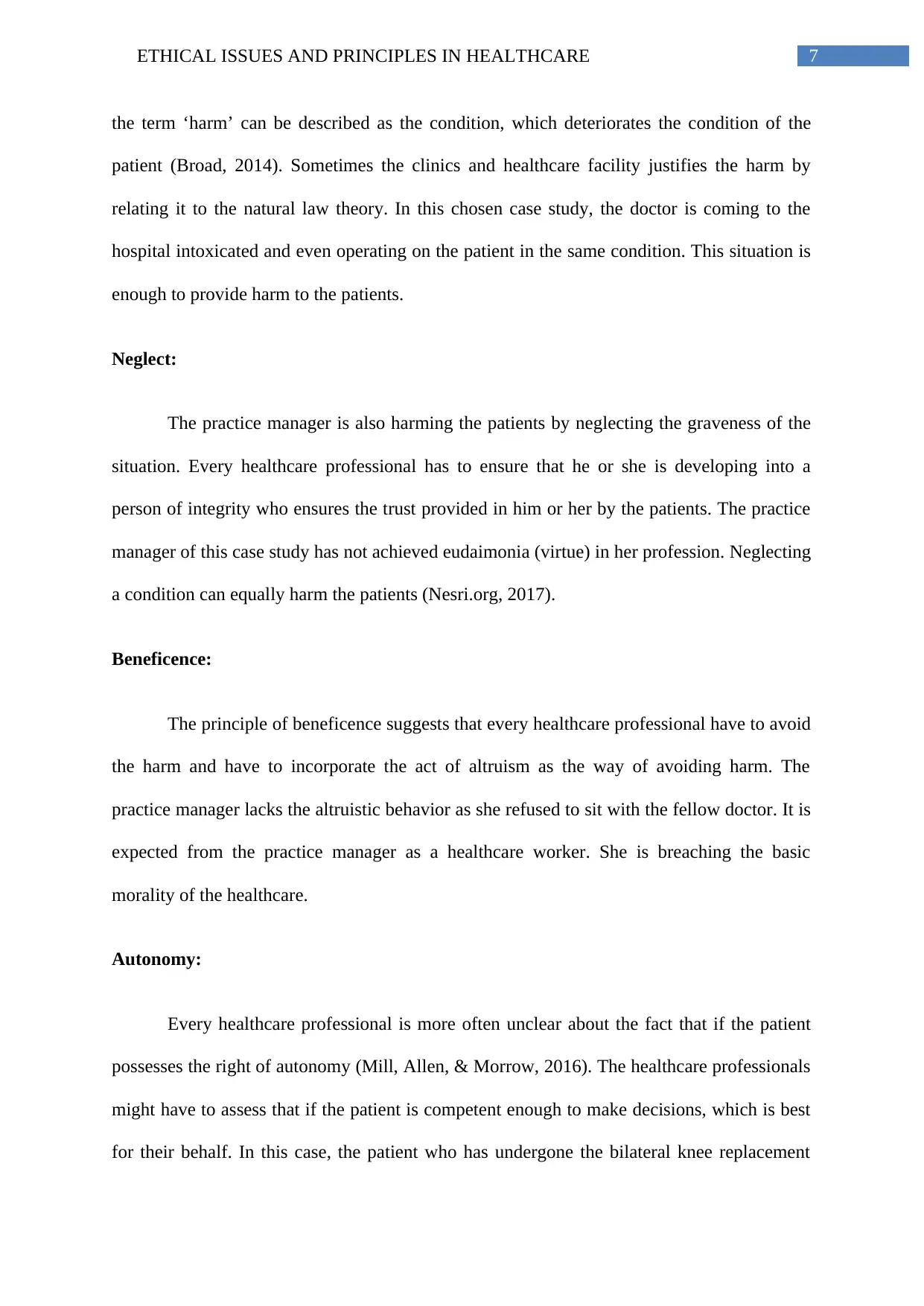
7ETHICAL ISSUES AND PRINCIPLES IN HEALTHCARE
the term ‘harm’ can be described as the condition, which deteriorates the condition of the
patient (Broad, 2014). Sometimes the clinics and healthcare facility justifies the harm by
relating it to the natural law theory. In this chosen case study, the doctor is coming to the
hospital intoxicated and even operating on the patient in the same condition. This situation is
enough to provide harm to the patients.
Neglect:
The practice manager is also harming the patients by neglecting the graveness of the
situation. Every healthcare professional has to ensure that he or she is developing into a
person of integrity who ensures the trust provided in him or her by the patients. The practice
manager of this case study has not achieved eudaimonia (virtue) in her profession. Neglecting
a condition can equally harm the patients (Nesri.org, 2017).
Beneficence:
The principle of beneficence suggests that every healthcare professional have to avoid
the harm and have to incorporate the act of altruism as the way of avoiding harm. The
practice manager lacks the altruistic behavior as she refused to sit with the fellow doctor. It is
expected from the practice manager as a healthcare worker. She is breaching the basic
morality of the healthcare.
Autonomy:
Every healthcare professional is more often unclear about the fact that if the patient
possesses the right of autonomy (Mill, Allen, & Morrow, 2016). The healthcare professionals
might have to assess that if the patient is competent enough to make decisions, which is best
for their behalf. In this case, the patient who has undergone the bilateral knee replacement
the term ‘harm’ can be described as the condition, which deteriorates the condition of the
patient (Broad, 2014). Sometimes the clinics and healthcare facility justifies the harm by
relating it to the natural law theory. In this chosen case study, the doctor is coming to the
hospital intoxicated and even operating on the patient in the same condition. This situation is
enough to provide harm to the patients.
Neglect:
The practice manager is also harming the patients by neglecting the graveness of the
situation. Every healthcare professional has to ensure that he or she is developing into a
person of integrity who ensures the trust provided in him or her by the patients. The practice
manager of this case study has not achieved eudaimonia (virtue) in her profession. Neglecting
a condition can equally harm the patients (Nesri.org, 2017).
Beneficence:
The principle of beneficence suggests that every healthcare professional have to avoid
the harm and have to incorporate the act of altruism as the way of avoiding harm. The
practice manager lacks the altruistic behavior as she refused to sit with the fellow doctor. It is
expected from the practice manager as a healthcare worker. She is breaching the basic
morality of the healthcare.
Autonomy:
Every healthcare professional is more often unclear about the fact that if the patient
possesses the right of autonomy (Mill, Allen, & Morrow, 2016). The healthcare professionals
might have to assess that if the patient is competent enough to make decisions, which is best
for their behalf. In this case, the patient who has undergone the bilateral knee replacement
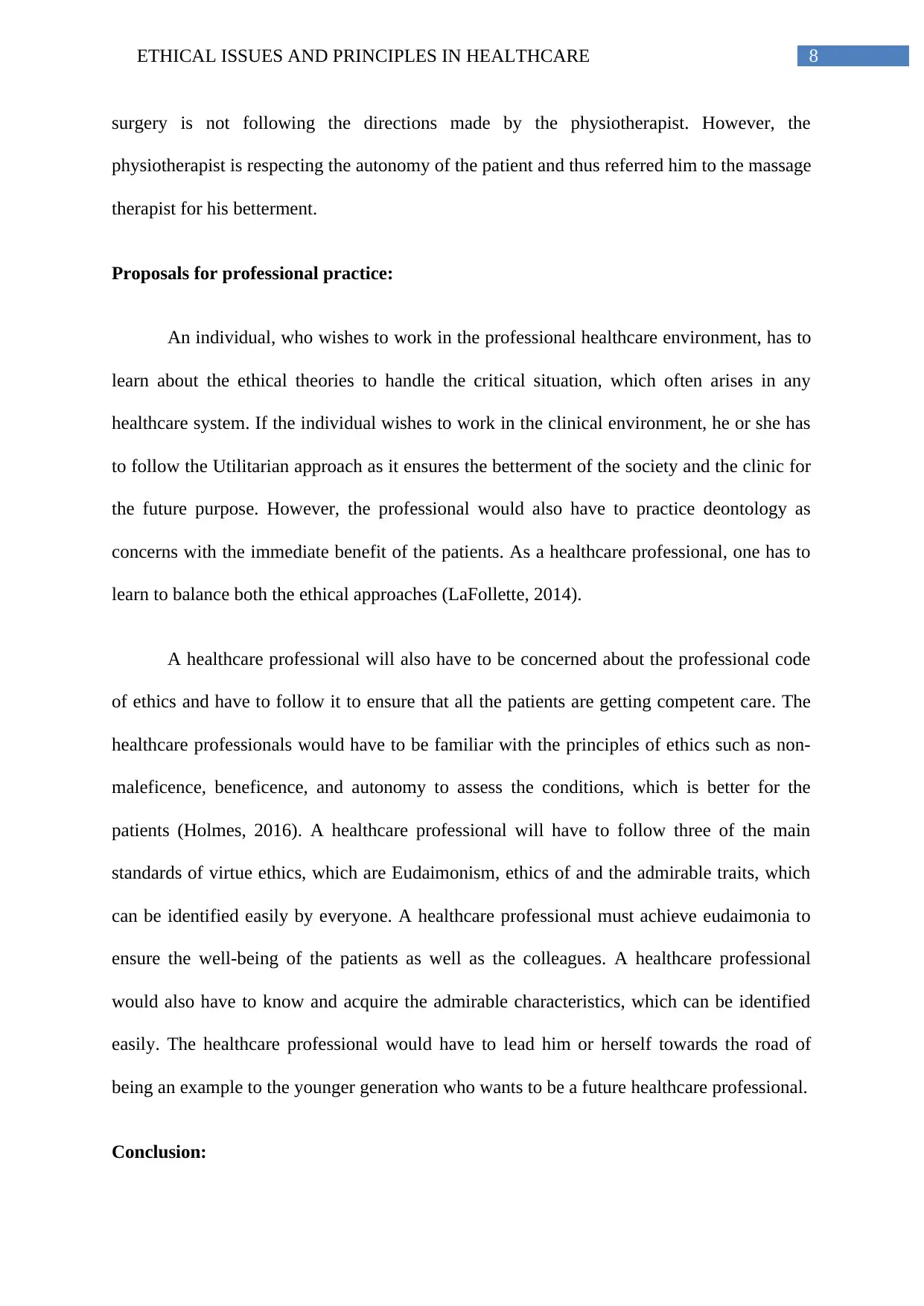
8ETHICAL ISSUES AND PRINCIPLES IN HEALTHCARE
surgery is not following the directions made by the physiotherapist. However, the
physiotherapist is respecting the autonomy of the patient and thus referred him to the massage
therapist for his betterment.
Proposals for professional practice:
An individual, who wishes to work in the professional healthcare environment, has to
learn about the ethical theories to handle the critical situation, which often arises in any
healthcare system. If the individual wishes to work in the clinical environment, he or she has
to follow the Utilitarian approach as it ensures the betterment of the society and the clinic for
the future purpose. However, the professional would also have to practice deontology as
concerns with the immediate benefit of the patients. As a healthcare professional, one has to
learn to balance both the ethical approaches (LaFollette, 2014).
A healthcare professional will also have to be concerned about the professional code
of ethics and have to follow it to ensure that all the patients are getting competent care. The
healthcare professionals would have to be familiar with the principles of ethics such as non-
maleficence, beneficence, and autonomy to assess the conditions, which is better for the
patients (Holmes, 2016). A healthcare professional will have to follow three of the main
standards of virtue ethics, which are Eudaimonism, ethics of and the admirable traits, which
can be identified easily by everyone. A healthcare professional must achieve eudaimonia to
ensure the well-being of the patients as well as the colleagues. A healthcare professional
would also have to know and acquire the admirable characteristics, which can be identified
easily. The healthcare professional would have to lead him or herself towards the road of
being an example to the younger generation who wants to be a future healthcare professional.
Conclusion:
surgery is not following the directions made by the physiotherapist. However, the
physiotherapist is respecting the autonomy of the patient and thus referred him to the massage
therapist for his betterment.
Proposals for professional practice:
An individual, who wishes to work in the professional healthcare environment, has to
learn about the ethical theories to handle the critical situation, which often arises in any
healthcare system. If the individual wishes to work in the clinical environment, he or she has
to follow the Utilitarian approach as it ensures the betterment of the society and the clinic for
the future purpose. However, the professional would also have to practice deontology as
concerns with the immediate benefit of the patients. As a healthcare professional, one has to
learn to balance both the ethical approaches (LaFollette, 2014).
A healthcare professional will also have to be concerned about the professional code
of ethics and have to follow it to ensure that all the patients are getting competent care. The
healthcare professionals would have to be familiar with the principles of ethics such as non-
maleficence, beneficence, and autonomy to assess the conditions, which is better for the
patients (Holmes, 2016). A healthcare professional will have to follow three of the main
standards of virtue ethics, which are Eudaimonism, ethics of and the admirable traits, which
can be identified easily by everyone. A healthcare professional must achieve eudaimonia to
ensure the well-being of the patients as well as the colleagues. A healthcare professional
would also have to know and acquire the admirable characteristics, which can be identified
easily. The healthcare professional would have to lead him or herself towards the road of
being an example to the younger generation who wants to be a future healthcare professional.
Conclusion:
⊘ This is a preview!⊘
Do you want full access?
Subscribe today to unlock all pages.

Trusted by 1+ million students worldwide
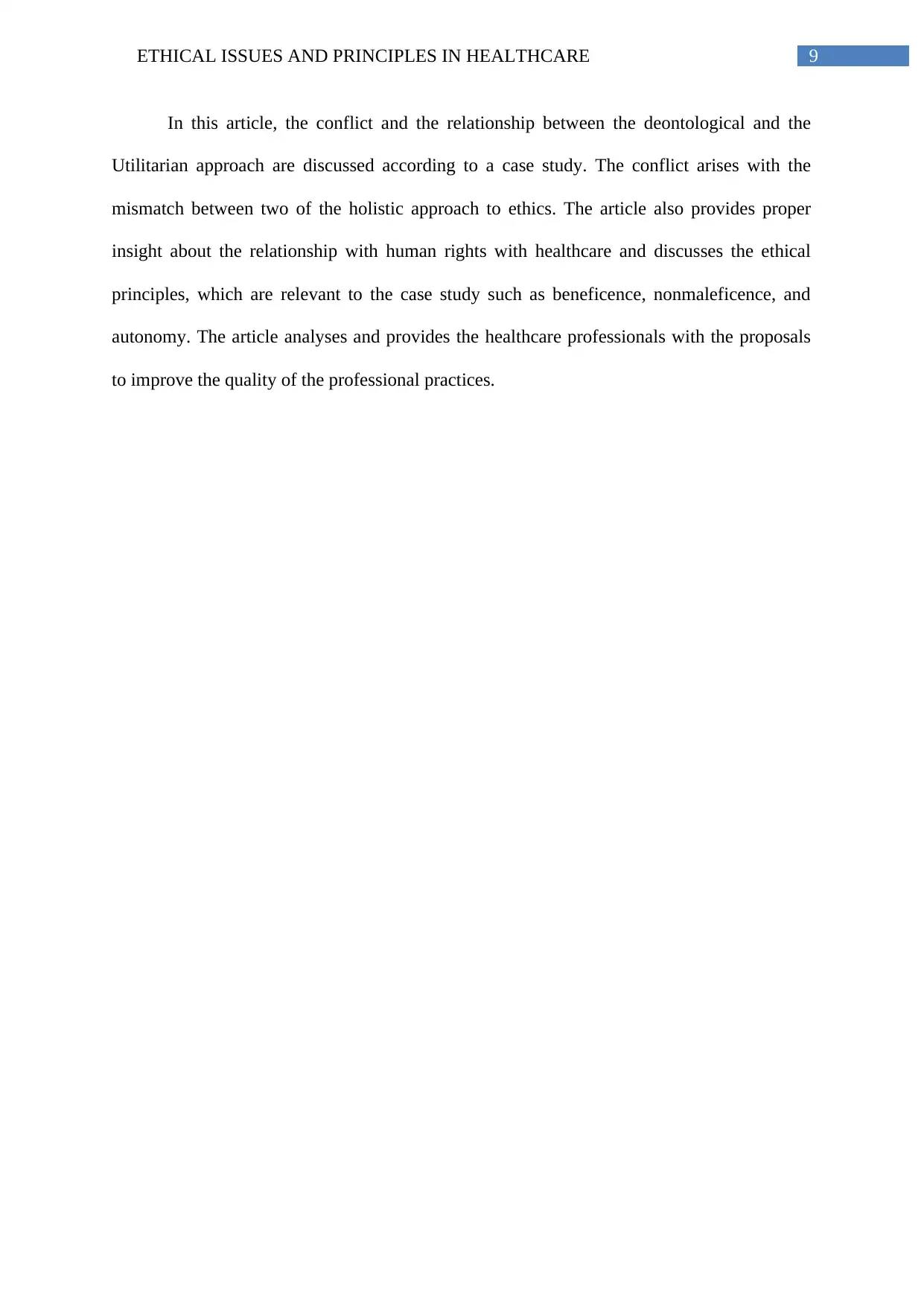
9ETHICAL ISSUES AND PRINCIPLES IN HEALTHCARE
In this article, the conflict and the relationship between the deontological and the
Utilitarian approach are discussed according to a case study. The conflict arises with the
mismatch between two of the holistic approach to ethics. The article also provides proper
insight about the relationship with human rights with healthcare and discusses the ethical
principles, which are relevant to the case study such as beneficence, nonmaleficence, and
autonomy. The article analyses and provides the healthcare professionals with the proposals
to improve the quality of the professional practices.
In this article, the conflict and the relationship between the deontological and the
Utilitarian approach are discussed according to a case study. The conflict arises with the
mismatch between two of the holistic approach to ethics. The article also provides proper
insight about the relationship with human rights with healthcare and discusses the ethical
principles, which are relevant to the case study such as beneficence, nonmaleficence, and
autonomy. The article analyses and provides the healthcare professionals with the proposals
to improve the quality of the professional practices.
Paraphrase This Document
Need a fresh take? Get an instant paraphrase of this document with our AI Paraphraser
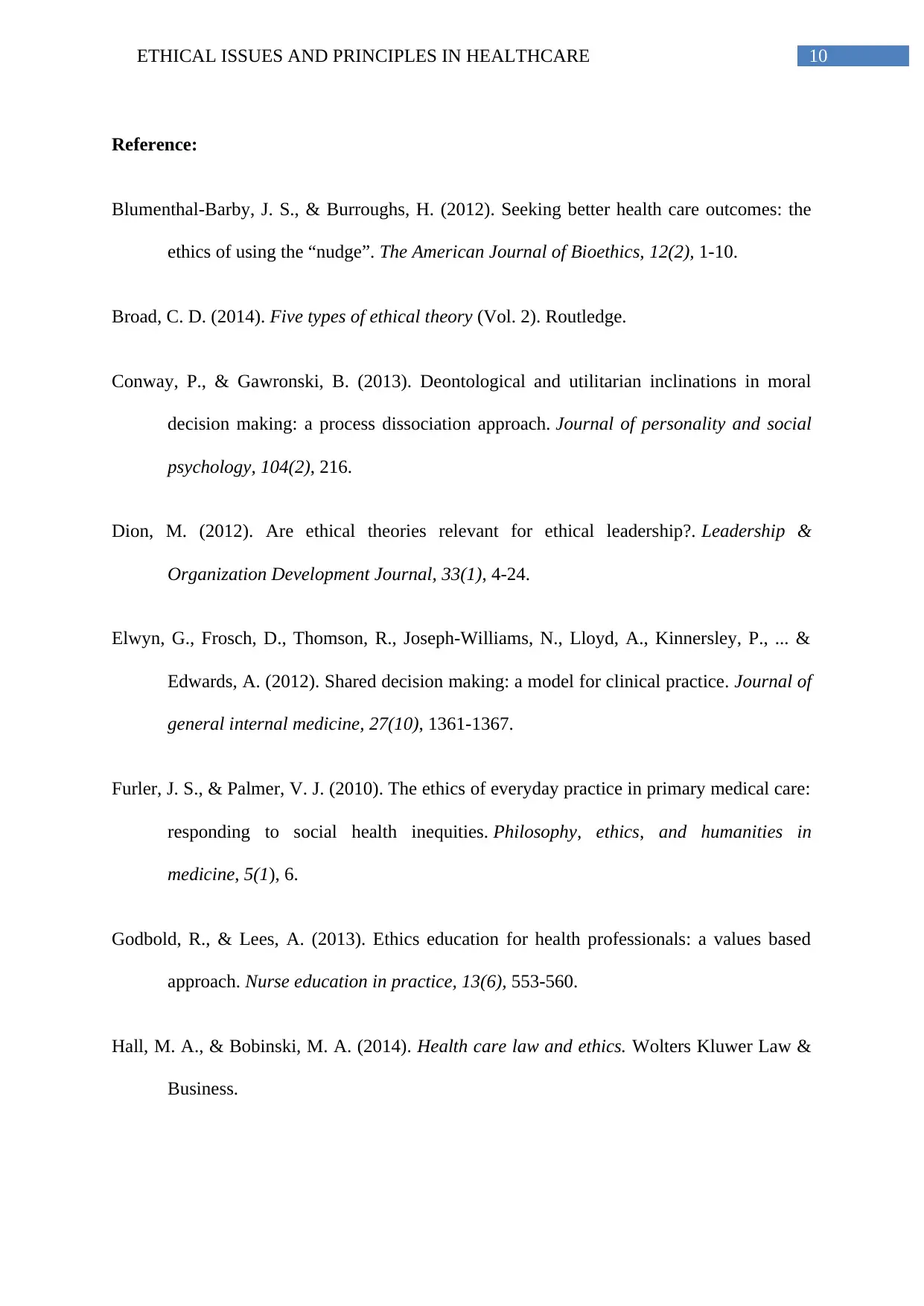
10ETHICAL ISSUES AND PRINCIPLES IN HEALTHCARE
Reference:
Blumenthal-Barby, J. S., & Burroughs, H. (2012). Seeking better health care outcomes: the
ethics of using the “nudge”. The American Journal of Bioethics, 12(2), 1-10.
Broad, C. D. (2014). Five types of ethical theory (Vol. 2). Routledge.
Conway, P., & Gawronski, B. (2013). Deontological and utilitarian inclinations in moral
decision making: a process dissociation approach. Journal of personality and social
psychology, 104(2), 216.
Dion, M. (2012). Are ethical theories relevant for ethical leadership?. Leadership &
Organization Development Journal, 33(1), 4-24.
Elwyn, G., Frosch, D., Thomson, R., Joseph-Williams, N., Lloyd, A., Kinnersley, P., ... &
Edwards, A. (2012). Shared decision making: a model for clinical practice. Journal of
general internal medicine, 27(10), 1361-1367.
Furler, J. S., & Palmer, V. J. (2010). The ethics of everyday practice in primary medical care:
responding to social health inequities. Philosophy, ethics, and humanities in
medicine, 5(1), 6.
Godbold, R., & Lees, A. (2013). Ethics education for health professionals: a values based
approach. Nurse education in practice, 13(6), 553-560.
Hall, M. A., & Bobinski, M. A. (2014). Health care law and ethics. Wolters Kluwer Law &
Business.
Reference:
Blumenthal-Barby, J. S., & Burroughs, H. (2012). Seeking better health care outcomes: the
ethics of using the “nudge”. The American Journal of Bioethics, 12(2), 1-10.
Broad, C. D. (2014). Five types of ethical theory (Vol. 2). Routledge.
Conway, P., & Gawronski, B. (2013). Deontological and utilitarian inclinations in moral
decision making: a process dissociation approach. Journal of personality and social
psychology, 104(2), 216.
Dion, M. (2012). Are ethical theories relevant for ethical leadership?. Leadership &
Organization Development Journal, 33(1), 4-24.
Elwyn, G., Frosch, D., Thomson, R., Joseph-Williams, N., Lloyd, A., Kinnersley, P., ... &
Edwards, A. (2012). Shared decision making: a model for clinical practice. Journal of
general internal medicine, 27(10), 1361-1367.
Furler, J. S., & Palmer, V. J. (2010). The ethics of everyday practice in primary medical care:
responding to social health inequities. Philosophy, ethics, and humanities in
medicine, 5(1), 6.
Godbold, R., & Lees, A. (2013). Ethics education for health professionals: a values based
approach. Nurse education in practice, 13(6), 553-560.
Hall, M. A., & Bobinski, M. A. (2014). Health care law and ethics. Wolters Kluwer Law &
Business.
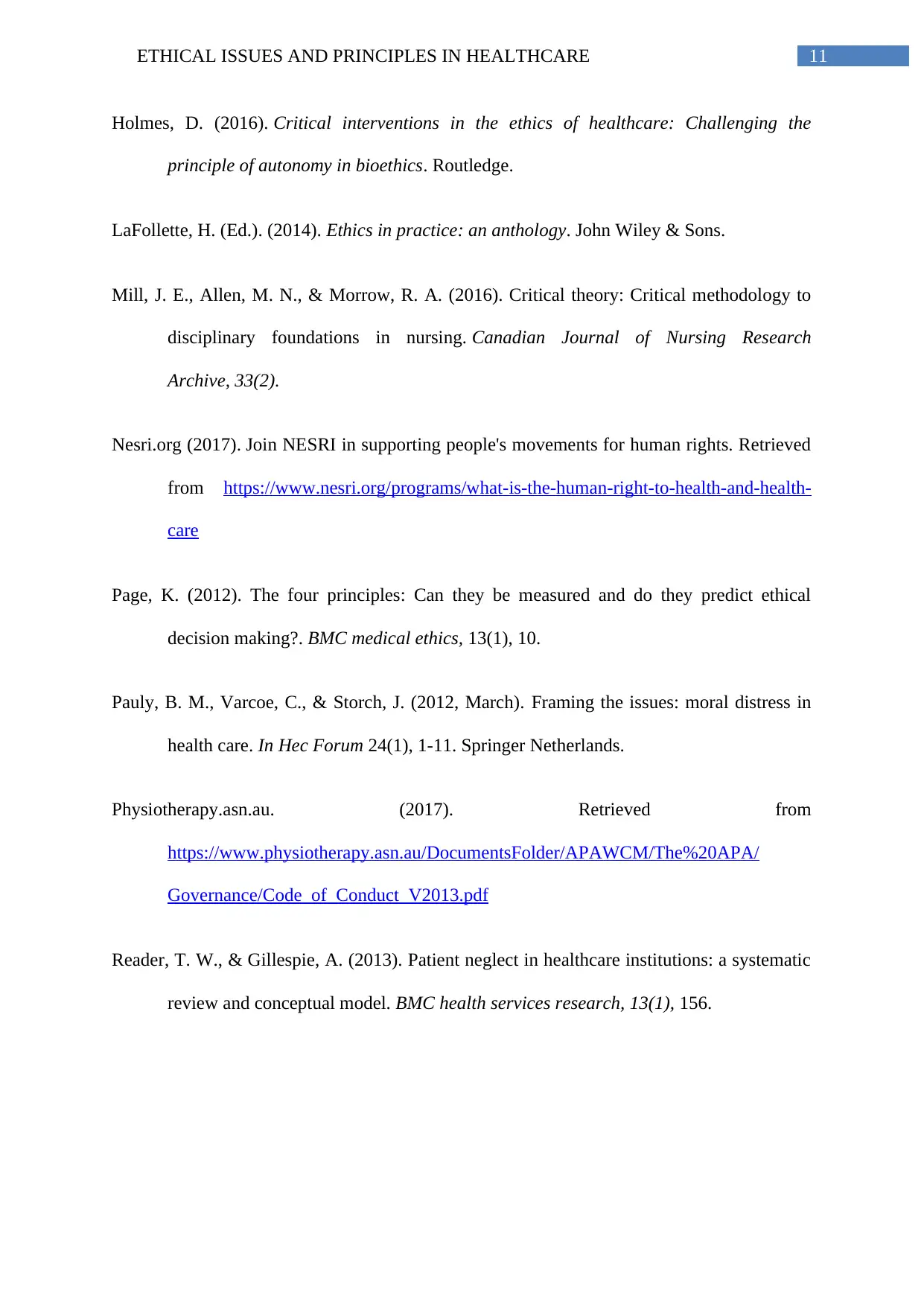
11ETHICAL ISSUES AND PRINCIPLES IN HEALTHCARE
Holmes, D. (2016). Critical interventions in the ethics of healthcare: Challenging the
principle of autonomy in bioethics. Routledge.
LaFollette, H. (Ed.). (2014). Ethics in practice: an anthology. John Wiley & Sons.
Mill, J. E., Allen, M. N., & Morrow, R. A. (2016). Critical theory: Critical methodology to
disciplinary foundations in nursing. Canadian Journal of Nursing Research
Archive, 33(2).
Nesri.org (2017). Join NESRI in supporting people's movements for human rights. Retrieved
from https://www.nesri.org/programs/what-is-the-human-right-to-health-and-health-
care
Page, K. (2012). The four principles: Can they be measured and do they predict ethical
decision making?. BMC medical ethics, 13(1), 10.
Pauly, B. M., Varcoe, C., & Storch, J. (2012, March). Framing the issues: moral distress in
health care. In Hec Forum 24(1), 1-11. Springer Netherlands.
Physiotherapy.asn.au. (2017). Retrieved from
https://www.physiotherapy.asn.au/DocumentsFolder/APAWCM/The%20APA/
Governance/Code_of_Conduct_V2013.pdf
Reader, T. W., & Gillespie, A. (2013). Patient neglect in healthcare institutions: a systematic
review and conceptual model. BMC health services research, 13(1), 156.
Holmes, D. (2016). Critical interventions in the ethics of healthcare: Challenging the
principle of autonomy in bioethics. Routledge.
LaFollette, H. (Ed.). (2014). Ethics in practice: an anthology. John Wiley & Sons.
Mill, J. E., Allen, M. N., & Morrow, R. A. (2016). Critical theory: Critical methodology to
disciplinary foundations in nursing. Canadian Journal of Nursing Research
Archive, 33(2).
Nesri.org (2017). Join NESRI in supporting people's movements for human rights. Retrieved
from https://www.nesri.org/programs/what-is-the-human-right-to-health-and-health-
care
Page, K. (2012). The four principles: Can they be measured and do they predict ethical
decision making?. BMC medical ethics, 13(1), 10.
Pauly, B. M., Varcoe, C., & Storch, J. (2012, March). Framing the issues: moral distress in
health care. In Hec Forum 24(1), 1-11. Springer Netherlands.
Physiotherapy.asn.au. (2017). Retrieved from
https://www.physiotherapy.asn.au/DocumentsFolder/APAWCM/The%20APA/
Governance/Code_of_Conduct_V2013.pdf
Reader, T. W., & Gillespie, A. (2013). Patient neglect in healthcare institutions: a systematic
review and conceptual model. BMC health services research, 13(1), 156.
⊘ This is a preview!⊘
Do you want full access?
Subscribe today to unlock all pages.

Trusted by 1+ million students worldwide
1 out of 12
Related Documents
Your All-in-One AI-Powered Toolkit for Academic Success.
+13062052269
info@desklib.com
Available 24*7 on WhatsApp / Email
![[object Object]](/_next/static/media/star-bottom.7253800d.svg)
Unlock your academic potential
Copyright © 2020–2025 A2Z Services. All Rights Reserved. Developed and managed by ZUCOL.





